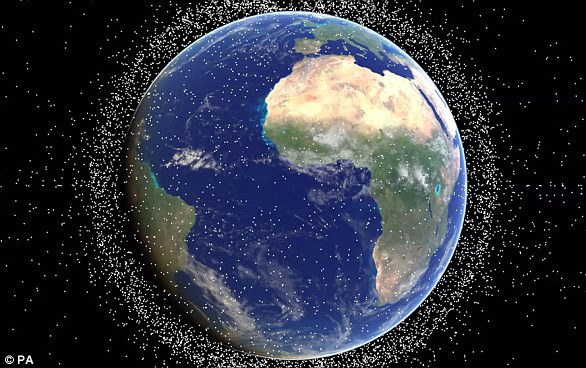There are an estimated 170 million pieces of so-called ‘space junk’ – left behind after missions that can be as big as spent rocket stages or as small as paint flakes – in orbit alongside some US$700 billion (£555bn) of space infrastructure.
But only 22,000 are tracked, and with the fragments able to travel at speeds above 16,777 mph (27,000kmh), even tiny pieces could seriously damage or destroy satellites.
However, traditional gripping methods don’t work in space, as suction cups do not function in a vacuum and temperatures are too cold for substances like tape and glue.
Grippers based around magnets are useless because most of the debris in orbit around Earth is not magnetic.
Around 500,000 pieces of human-made debris (artist’s impression) currently orbit our planet, made up of disused satellites, bits of spacecraft and spent rockets
Most proposed solutions, including debris harpoons, either require or cause forceful interaction with the debris, which could push those objects in unintended, unpredictable directions.
Scientists point to two events that have badly worsened the problem of space junk.
The first was in February 2009, when an Iridium telecoms satellite and Kosmos-2251, a Russian military satellite, accidentally collided.
The second was in January 2007, when China tested an anti-satellite weapon on an old Fengyun weather satellite.
Experts also pointed to two sites that have become worryingly cluttered.
One is low Earth orbit which is used by satnav satellites, the ISS, China’s manned missions and the Hubble telescope, among others.
The other is in geostationary orbit, and is used by communications, weather and surveillance satellites that must maintain a fixed position relative to Earth.
